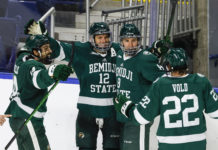This offseason started with the belief, at least on this end, that by the time the 2012-13 season came around we’d have knowledge of the locations of more upcoming Frozen Fours and clarity on the future of face shields.
Not so much, it appears.
Talk from some members of the Division I men’s ice hockey committee in Tampa in April was that the group was looking to select the venues for the 2015, 2016 and 2017 Frozen Fours this summer.
That may have been a stretch to begin with, and with new NCAA executive vice president for championships and alliances Mark Lewis just coming on board in April, the bidding process was never opened.
Pushing the bidding back means that it’s likely that when we gather in Pittsburgh for the 2013 Frozen Four, we will know the location of only one future event — Philadelphia in 2014.
That goes against a recent trend. Site selections were made at least four years out in 2000, 2003 and 2005, and Pittsburgh got three years advance notice.
But it appears the 2015 host will have just two years to get ready. It sounds like plenty of time, but remember that advances in Frozen Four player and fan experiences often get sparked by future hosts gathering info at the event. In the likely case that the announcement is made after the Pittsburgh Frozen Four, the 2015 host will have just one such opportunity.
That makes the job of the committee in finding the right 2015 host all the more critical. It’ll be an interesting welcome to the job for Tom Nevala, a Notre Dame senior associate athletic director who takes over as committee chair on Sept. 1.
As for the face shields, expect to see either the full shields or the full cages on men’s hockey players for at least the next two seasons.
In June, the NCAA Committee on Competitive Safeguards and Medical Aspects of Sports said it would need “significant safety data” on three-quarters face shields before it can sign off on allowing them to be used.
That wasn’t unexpected, and the rules committee has already started to accumulate that data. The USHL started using three-quarters shields last season, so that information will go into consideration.
But because no change is being made this season and the NCAA works on a two-year rules cycle, the next chance for a proposal is in 2014, said rules committee chair Ed McLaughlin, also the athletic director at Niagara.
The push for less facial protection is rooted in the belief that it would make players more aware of their vulnerability and, in the end, decrease major injuries. You can imagine how it could be difficult to convince safety committee members that less protective equipment equals more protection.
That’s the challenge for the committee and the hockey community over the next two seasons. Stay tuned.
